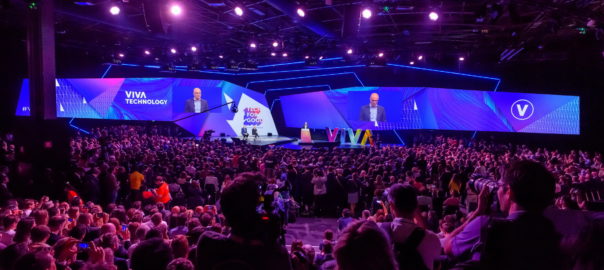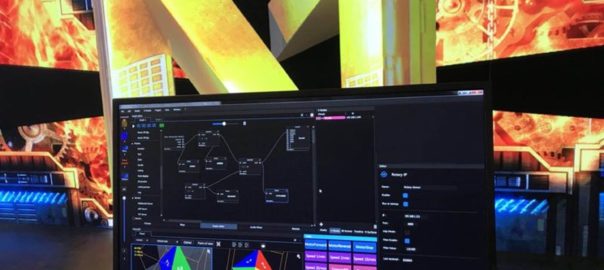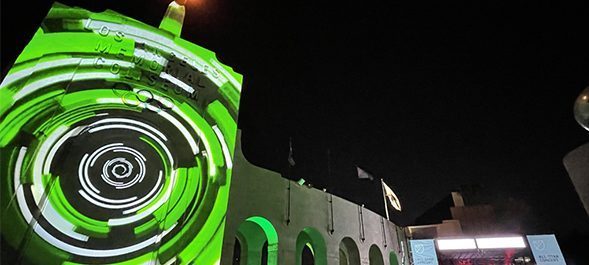Stage direction: Jean-Louis Grinda
Sets and lights: Laurent Castaing
Images: Arnaud Pottier
Video-projection consulting: Renaud Gindre
Photo credit: Charlotte Maurel
The Capitole de Toulouse Opera relies on Modulo Pi’s auto-calibration and media server solutions
During the summer of 2023, the Capitole de Toulouse National Opera hosted Mefistofele, a lyrical work in the form of a tragicomic fresco. Video was central to the staging of this opera, with an ambitious projection on a conch shell installed on the Théâtre du Capitole stage. To ensure the distribution of the video creation, the Capitole de Toulouse teams called on various Modulo Pi solutions, including its projection study tools and video-projector auto-calibration module.
From June 23 to July 7, 2023, the Capitole de Toulouse National Opera hosted Mefistofele, an opera adapted from Goethe’s famous tragedy. Directed by Jean-Louis Grinda, the opera took place within a conch-shaped video set on which Arnaud Pottier’s video creation was projected.
With a base width of 15.75m, a top width of 8.70m and a height of over 9m, the imposing quarter sphere occupied the entire stage space of the Théâtre du Capitole, serving as an immersive backdrop for the artists on stage.
While such a set offered perfect immersion in the heart of the work throughout the 3-hour opera, the AV production team faced several challenges with its installation and calibration.
Pierre-Emmanuel Triffault, Head of Audiovisual at the Capitole de Toulouse Opera, explains: “The main challenge came from the shape of this projection surface. How can we get sufficient light power to evenly cover such curved surface, and how can we position the projectors knowing that there are singers on stage and the projectors must not be too noisy, nor project onto the singers’ faces?”
This opera accompanied by its video production having already been performed at the Monte-Carlo Opera in the past, the projection system then used was recommended for the Toulouse dates. “The recommended positioning of the video-projectors was very restrictive, and we were unable to set it up in our hall” reports Pierre-Emmanuel Triffault.
On the advice of Renaud Gindre, video consultant on the project, the Capitole de Toulouse Opera‘s AV team turned to various solutions developed by the Modulo Pi company, including the Modulo Kinetic media server’s projection study and simulation tools, as well as the video-projector auto-calibration module.
Pierre-Emmanuel Triffault explains:
“Thanks to Modulo Kinetic‘s simulation tools, we saw that we could free ourselves from many constraints. What started out as very complicated would ultimately become simple.”
While the initial brief recommended using 4 x 30,000 lumen video-projectors, placing 2 projectors at the top, 2 at the bottom, crossing their beams and warping the images, the projection study carried out in Modulo Kinetic made it possible to simplify the setup while guaranteeing optimal light output.
“By importing a point cloud of the theater into Modulo Kinetic and simulating our projectors, we realized that we could finally place our 4 VPs aligned on the truss, at the highest part of the set, and that the auto-calibration tool would then do the warp that we technicians were not capable of doing” says Pierre-Emmanuel Triffault.
The projection study led to the selection of 4 x Epson EB-PU2216B projectors with a power of 16,000 lumens, to produce an image of 3144 x 1200 pixels.
Once the choice and positioning of the projectors had been validated, the other challenge was to project a uniform image onto the quarter sphere and its curved surface. To avoid time-consuming manual calibration and obtain a perfectly homogenous image with no hot spots, Modulo Pi‘s multi-projectors auto-calibration solution was used with the Modulo Player media server which the Opera has been equipped with since 2017.
Thanks to the auto-calibration module available as an option in the media server, the overlap areas and warping work – particularly complex elements for curved surfaces – were automatically calculated by Modulo Player in just a few minutes. This enabled the projection system to be set up and adjusted in record time.
“We have to deal with very tight set-up times involving different trades. When it comes to phasing in opera, the machinery and set teams are involved first, then lighting, and video comes last. Thanks to the projection study carried out beforehand, the projectors were installed in one afternoon. The auto-calibration tool enabled us to adjust the mapping in 4 minutes, rather than spending a whole day on it” notes Pierre-Emmanuel Triffault.
During rehearsals, the video creation work could be tested and evolved live thanks to an NDI stream received by Modulo Player, enabling a preview of the videos mapped onto the conch. Alexis Gérard, Production Manager for the show, comments:
“The NDI previewing from After Effects is an argument that struck a chord with the videographer. I was given over 30 different versions of the same video. If we had to export them all, it would have taken forever.”
Finally, Modulo Player‘s automation functions were used to control the projectors shutters. Thanks to tasks programmed into the media server, the shutters closed automatically when the stage needed to go black, thus avoiding video blacks from the projectors.




























